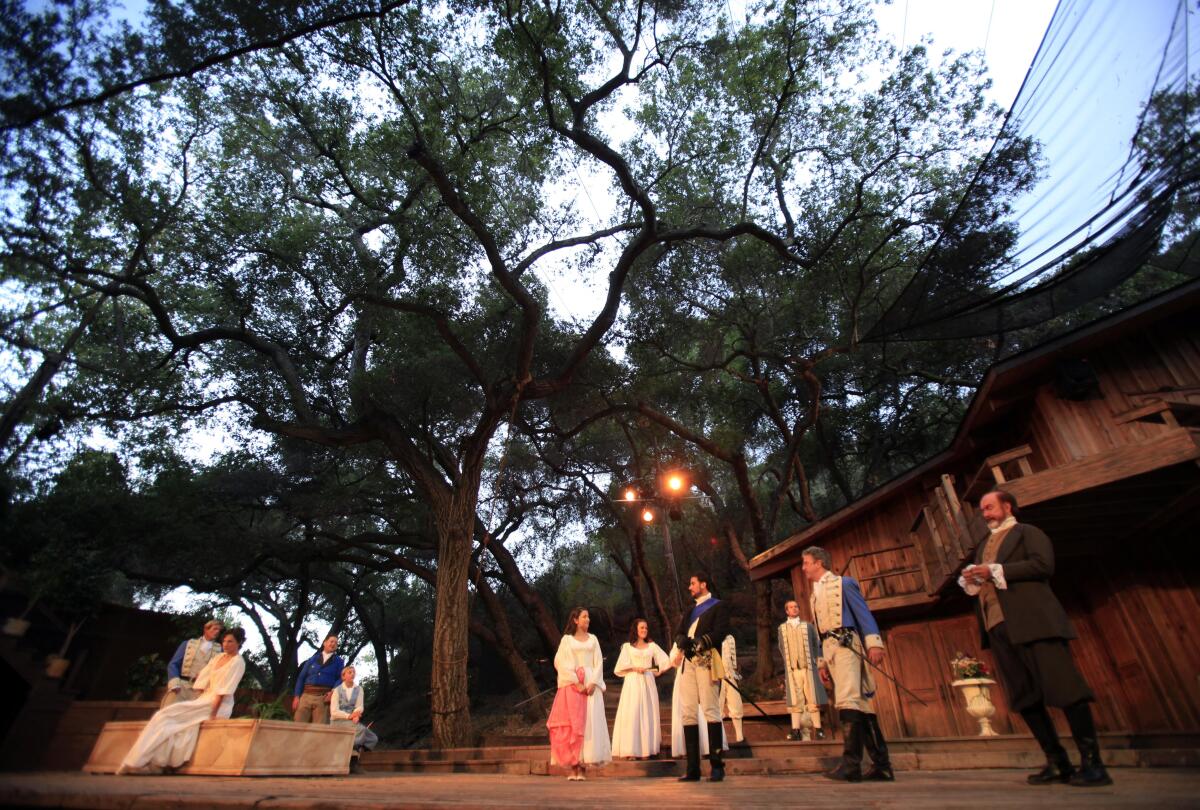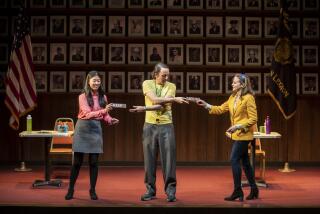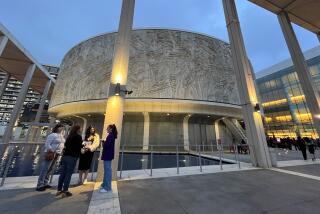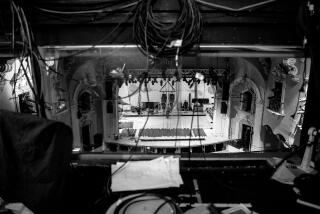Live music and theater in L.A. will happen outdoors in summer. But it won’t be easy
- Share via
If a theater is at 50% capacity, is it half full or half empty?
As Los Angeles and Orange counties edge closer to the orange tier in California’s COVID-19 restrictions system, companies that stage live performance are cautiously optimistic that the region is poised for a summer of cultural diversion and togetherness — outdoors — after more than a year of pandemic separation.
So many questions, however, lurk in the numbers: the number of performers allowed onstage, the number of guests allowed in the audience. The number of masks and hand sanitizer dispensers that must be purchased, the number of COVID-19 tests that need to be administered. The number of dollars needed for air purification and recirculation systems, the number of days until it gets too cold again for outdoor performances.
Not being able to operate at full capacity, even outdoors, is a huge challenge for pandemic-starved companies, said Independent Shakespeare Company’s co-founder and managing director, David Melville. The company is largely sustained through its annual summer festival in Griffith Park, which can attract up to 1,000 people a night.
“We’re on such a tight margin. We rely on donations generated from performances, so in terms of feasibility anything less than 100% isn’t feasible, but if we were only going to do things that are feasible, we wouldn’t have started this company,” he said. “I think equally unfeasible is not doing it.”
For now, the company has pushed its opening from June to late July and plans to run through Labor Day, but Melville said he expects the situation to remain unnervingly fluid. Griffith Park has yet to sign off on holding shows in the park because it is still waiting on guidance from California’s Department of Public Health. Meanwhile, construction continues on a new outdoor stage, so if shows do happen this summer, they might need to be relocated.
Many arts organizations said business as usual will not return for months — perhaps years. Institutions that have outdoor areas are intent on making use of that space, while groups that don’t are focused on securing an outdoor site. Large venues that would lose money operating at reduced capacity are instead mostly planning online shows for summer while hoping for a brighter, less distanced fall.

Until early March, live performance had been entirely left out of the California health department’s color-coded blueprint for reopening. Beginning April 1, live performance outdoors can restart at 20% capacity in the red tier, which most of the state, including L.A., occupies. When counties enter the orange tier, as L.A. and Orange counties are expected to do next week, that number rises to 33%. In the yellow tier, capacity limits lift to 67%.
There are two gaping holes in these guidelines. First, that guidance applies only to outdoor venues with fixed seating, like the Hollywood Bowl, and despite the good weather in Southern California, not many organizations have that kind of permanent space. No guidelines have been established for COVID-minded pop-up stages, such as what the Fountain Theatre has planned for its parking lot.
Second, no guidelines exist for indoor performances either. It’s impossible for venues to plan, and that’s particularly true for large venues that typically book touring Broadway shows and would need at least six months of lead time.
“Agitation is becoming quite high that our sector is still shut down when businesses that are analogous are reopening,” said Martha Demson, board president of the Theatrical Producers League of Los Angeles, an association for small and midsize nonprofit theaters. By contrast, movie theaters, theme parks and indoor dining have resumed at various capacities.
Demson is part of a COVID-19 safety task force including theatrical labor unions that lobbied the county health department for an incremental restart of live performance. Their recommendations included the return of indoor performances for counties in the yellow tier and permission for outdoor pop-up stages in places such as parks and parking lots.
The county’s ability to implement such guidelines is contingent upon approval from the state health department. A representative for the state told The Times that more granular details about rules for live performance are forthcoming.
In the meantime, arts organizations are trying to plan for summer and fall in an information vacuum. The three keywords, said Rachel Fine, executive director and chief executive of the Wallis Annenberg Center for the Performing Arts in Beverly Hills: unprecedented, flexible and pivot.
“We’ve pivoted so many times,” Fine said, adding that the Wallis set up a pandemic resiliency fund that will help to fund outdoor performances with limited capacity, pending permission from the county. “We’re very fortunate to have a campus with a variety of spaces that could conceivably be used as outdoor spaces.”
Even organizations used to the outdoors, such as Will Geer’s Theatricum Botanicum, which has operated an open-air theater in Topanga Canyon since 1973, expect an element of surprise.
“I just can’t get in a big, huge stew about it because it’s going to evolve,” said Theatricum’s artistic director, Ellen Geer. “It’s gonna change tomorrow, and you just gotta go with the flow.”
Theatricum is planning to open after July 4, staging three plays instead of five. The shows will feature fewer actors, and interns won’t be running around. But audiences will be together — socially distanced — experiencing the healing power of live theater, Geer said.
New York-based Actors’ Equity Assn., the union for performers working in live theater, has released its own set of COVID-19 safety guidelines for theaters using union actors. And that added layer of rules can feel overwhelming for theaters grappling with an enormous amount of new information.
Gail Gabler, the western regional director for Equity, said 15 inquiries are pending for indoor and outdoor productions in California. Gabler recognized that some theaters have more money than others to achieve compliance, which can include costly measures such as upgraded air filtration systems. But Gabler said the union regularly advocates for more state funding for arts groups.
“Theaters have been very hard-hit and, frankly, they are underfunded in the first place,” she says. “And now we can’t sell full houses, and we need HVAC systems.”
Many organizations said they are fortunate to have received government pandemic relief. But that money will go quickly if it’s spent on budget-busting, limited-capacity shows, said Jon Lawrence Rivera, artistic director of Playwrights’ Arena. For small houses like his, 25% capacity would be about 12 people, so heading outdoors is the only real option if he wants to play to a larger audience.
Rivera said he’s hoping to avoid that grim scenario by staging work in the Atwater Village Theatre courtyard. In that space he estimated he could safely host 20 to 25 people.
The midsize East West Players in downtown L.A. plans to continue with a virtual season and hopes to add live outdoor performance into the mix when the county allows it. Artistic Director Snehal Desai said the goal is to bring roving, site-specific performances to neighborhoods like Chinatown and Little Tokyo.
“Those areas have been decimated, and the anti-Asian rhetoric has made people that much more fearful to gather in those neighborhoods,” he said.
Desai said the company generally spends about $250,000 or more on one of its musicals, and that number would be problematic if his 220-seat theater was allowed to host only 60 audience members. Plus, he worried about what that kind of distanced experience would feel like.
“I want us to come back when it feels safe and it feels welcoming, and we’re not more isolated five seats apart,” Desai said.
But long before that day arrives, theater leaders said, they need detailed guidelines — and as much lead time as possible.
“Various elected officials knew there was a lack of guidance, but I don’t think they understood how critical lead time was,” said Casey Reitz, president of Segerstrom Center for the Arts in Costa Mesa. “We’re not trying to open a 3,000-seat theater tomorrow, but we need to know the conditions under which we’ll be allowed to open a 3,000-seat theater.”
In the meantime, Segerstrom is planning outdoor performances for socially distanced audiences on its plaza — pending the guidelines.
Jean Davidson, president and chief executive of the Los Angeles Master Chorale, the resident chorus of Walt Disney Concert Hall, echoed Reitz’s concerns.
“What we need are reopening guidelines for indoor performances so that we can create financial models for next fiscal year, and the next several years, based on approved guidelines instead of assumptions,” Davidson said, adding that the Master Chorale is projecting that it may take years to rebuild its audience for indoor performances.
When it comes to performing outdoors, Davidson noted that the Master Chorale’s business model relies on larger audience capacity. Disney Hall seats 2,200.
“The financials don’t work unless we have access to a venue like the Hollywood Bowl, which has an 18,000-seat capacity, or close to 2,200 seats at about 15% capacity,” Davidson said.
More to Read
The biggest entertainment stories
Get our big stories about Hollywood, film, television, music, arts, culture and more right in your inbox as soon as they publish.
You may occasionally receive promotional content from the Los Angeles Times.











